I have never been a portrait shooter – and as much as I find satisfaction (the reasons why we will discuss in due course) in a well-executed portrait, I don’t think it will ever be the mainstay of my photographic repertoire. The reason is both simple and complex: a portrait is not a photograph of the physical person – it’s a visual representation of your relationship with that person. A sort of mirror, if you will; even though all subjects reflect light and thus the environment to some degree, there are more and less reflective ones. Highly polished objects can land up being entirely representations of their surroundings only, with the merest interference of interpretation; one of the tenets I live by in watch/jewellery photography has always been ‘light for the reflection’. That’s not really relevant to portraiture, or is it?
The most memorable portraits tend to be the ones where you feel the subjects are staring straight through the photograph and looking at you directly as you view the photograph. They should make you feel slightly uneasy because you are looking into the eyes of the person on the other side, not a two dimensional representation of them. But of course while the portrait is being made, they have to look through the lens/camera at you, the photographer. The only way this glance can be meaningful is if the subject intends there to be meaning, and the only way for them to intend there to be meaning is if there is something to communicate in the first place. Though people say the eyes are the window to the soul, the reality is we make both conscious and subconscious use of eye contact in communication to either assess sincerity of the other party, or impart it of our own. The photograph is now a representation of that communication: therefore, there simply cannot be anything to represent if there was nothing communicated between the subject and the camera (photographer).
Actually, I believe what differentiates a really good model from an amateur one is the ability to make you feel some sort of emotion when you look at them (and by extension, photographs of them) because they have the awareness to control their facial features or expressions to stimulate some sort of reciprocity in whoever is looking at them, even if there is no basis for a relationship of any sort. You (as photographer) may never have met them until five minutes ago; yet you might find yourself genuinely caring. It’s one thing to have awareness of one’s body, limbs and posture and be able to control that fully – but quite another to do the same thing with your facial muscles, simply because there’s a lot of involuntary stuff going on – and the vast bulk of the population tends not to practice expressions in the mirror much*. Being neither a model nor particularly expressive (though perhaps not as bad as Zoolander) – I can only imagine that it’s a rare mix of both conscious control and natural effusiveness of personality that’s required.
*That said, with the current popularity of selfies – perhaps the duck face has been perfected by a wider audience than usual, though I don’t feel anything much but revulsion.
I think it’s also important that we differentiate between a portrait and a fashion image: I consider the former to be honest, with integrity, and faithfully representing what we see: there is some effort in making the best presentation (context, light, perspective, composition) but not so much effort as to deliberately hide flaws and represent something the person perhaps is not. The latter kind of image is necessarily an exercise in fantasy rather than one of fidelity: it is intended to make you feel a certain way and want a certain relationship with that person or thing they’re selling; it’s designed to invoke desire rather than an understanding of personality. Here’s a complicated thought: a portrait that is honest may or may not be flattering; but a flattering portrait is frequently not honest. Nobody is perfect, which means our relationship with them is not, either – which means that any representation of it (i.e. the portrait) needs to somehow reflect this. I realise there’s a very flimsy line between what’s transient and unimportant (e.g. a pimple) and what’s significant (e.g. aged skin, grey hair, eye color etc.), and it’s not always easy to differentiate. Perhaps we’re back to emotion: does you feel like you’re looking at a real person, or an idealised one?
Quality of light plays a very big role in this: reality very seldom presents us with ideally clean, directional, diffuse light – it’s usually muted or harsh or full of other strange elements due to contextual sources. I’ve experimented with everything from unchanged available light (i.e. subject not even moved, at the risk they might lose their expression) to 100% constructed setups. As much as I aesthetically am drawn to the cleanliness of a constructed studio setup, I find that the cleanliness of it (both light and background) tends to detract from the honesty of the portrait. It’s as though the individual is somewhat lacking in personality, or is perhaps a bit simple. I personally favour a mixed approach: expose slightly below (if low key) or above (if high key) ambient to preserve context but reduce the visual prominence of anything that isn’t your subject, then use a large directional but diffuse source (think gridded wide strip, or gridded octa depending on the distance of the person from the background and the degree of spill desired) to provide the key light. The subject should be positioned somewhat in shadow to begin with so that the added light creates shadows and differentiation rather than overexposure and hotspots. Note consistency of style in the illustrative images: this is of course intentional (and I hope makes more sense in the context of yesterday’s post…)
What’s in the background is very important, too – it provides context, mood, even if not consciously examined by the audience. It’s one of the reasons I prefer real environments over created ones – the little details feel authentic, and though we might create those details in our sets – they require a lot more work than one usually has time for during a casual portrait. There are enough things that we need to be in control over (or conscious of) as it is; it’s much easier to select background, set up light, and then focus only on communicating with your subject and watching their facial expressions. Most people who are not regularly in front of a camera tend to be highly self conscious whenever there’s a conspicuous setup (one more reason to go minimalist) and aren’t really in control of their expressions or body language; this is especially true if you do not know them outside of a professional photography context. It is therefore the photographer’s job to coax and coach them into being themselves; I find that once the first few shots are over – the ‘expected’ ones where the subject is on guard – the anticipation is let out, the subject relaxes, and your task becomes easier. I like to not be behind the viewfinder for this part; I’ll stand around or use a remote release and then carry on a conversation with them on whatever topic they’re interested in (to aid relaxation) and watch for the right facial expressions. Rarely do they notice the flash going off. And almost always, the best images are the ones from this part of the session. It’s also flattering in perspective to have the camera a little lower than eye level (but have the subject communicate with you at eye level) as it avoids tilting downwards and changing the apparent proportions of the body.
Personally, I’ve always found human subjects very challenging – not least because I’m quite introverted and have some degree of Asperger’s. In practice, it means that eye contact is somewhat uncomfortable for me (though I’ve trained myself to do this during conversation) and most of the time, I have trouble reading/ interpreting emotions. I suspect this would be a problem if I was to exclusively shoot portraits, but for the most part as an amateur in this regard – I simply need to wait for one of two things: either an interesting (read: unusual) expression, or the expression that first comes to mind when I think of that subject. It’s a distillation of personality: I am representing them the way I remember them (that may or may not be the way they wish to be remembered – that’s where subjectivity and relationship come into play) – a sort of essence of character, if you will. It’s probably also the reason I find portraiture both frustrating and fascinating: unlike an object that is static and thus has one or two really representative views, paired with the right light, a human face is constantly and dynamically reflecting its surroundings and the people it’s interacting with. This means there is no ‘one image represents the person’ in entirety; it’s simply not possible. But perhaps as our relationship with the subject evolves and deepens, the way we represent them will do so, too. MT
__________________
More info on Hasselblad cameras and lenses can be found here.
__________________
Visit the Teaching Store to up your photographic game – including workshop videos, and the individual Email School of Photography. You can also support the site by purchasing from B&H and Amazon – thanks!
We are also on Facebook and there is a curated reader Flickr pool.
Images and content copyright Ming Thein | mingthein.com 2012 onwards unless otherwise stated. All rights reserved
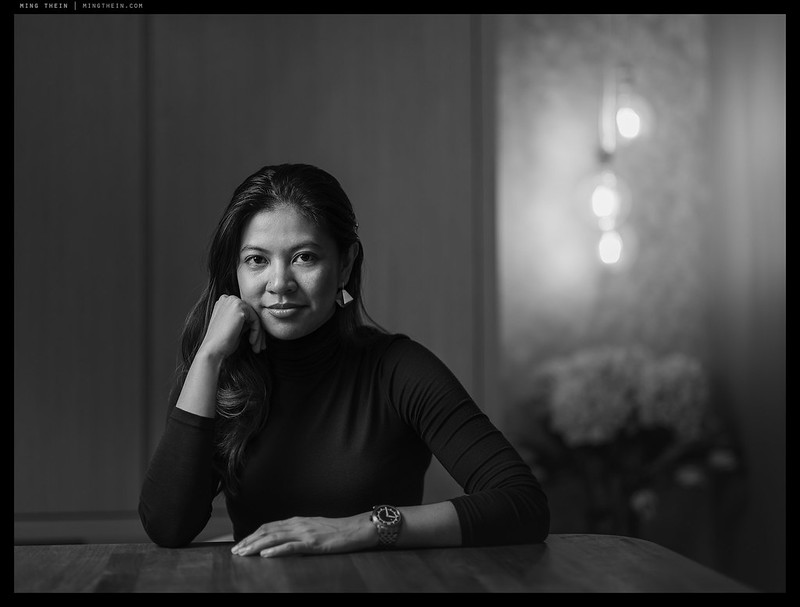
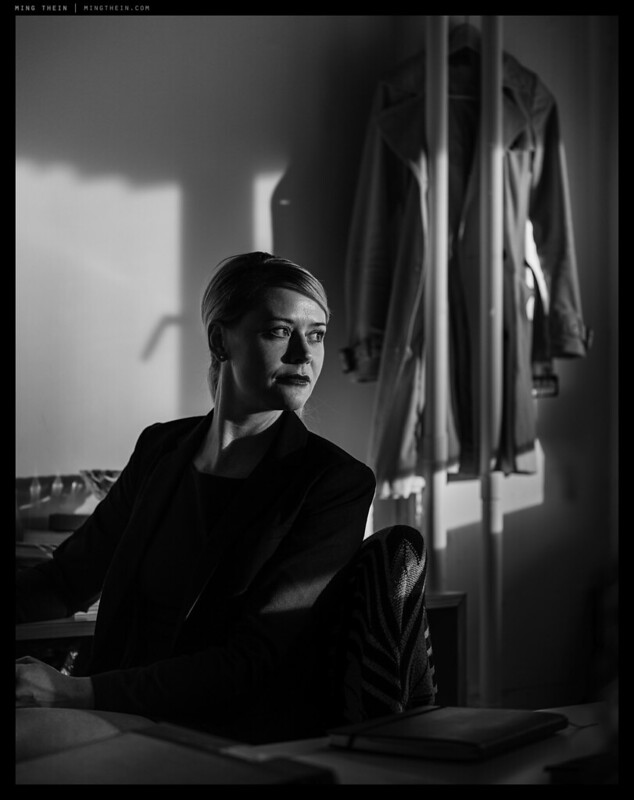
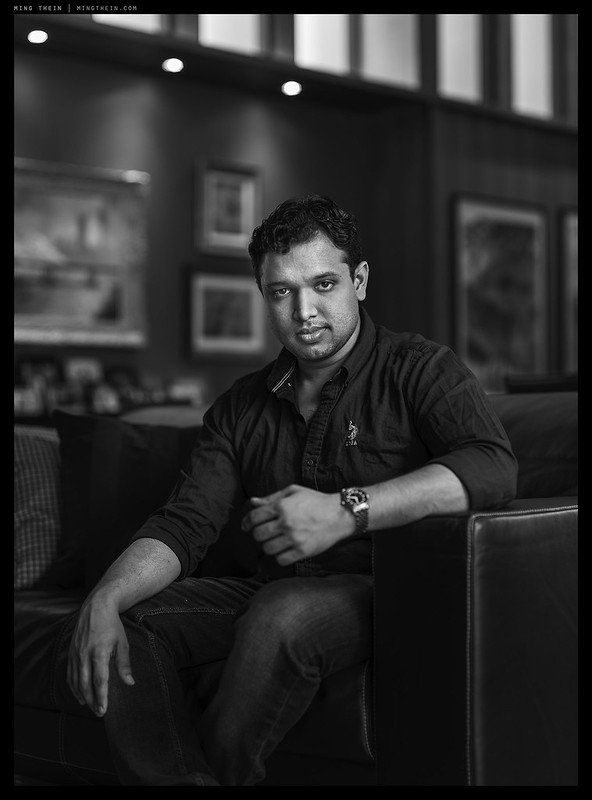
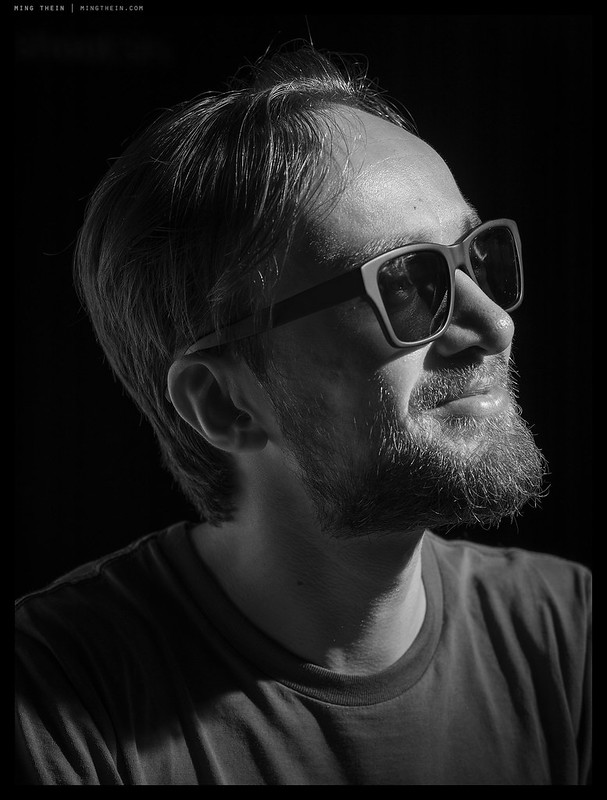
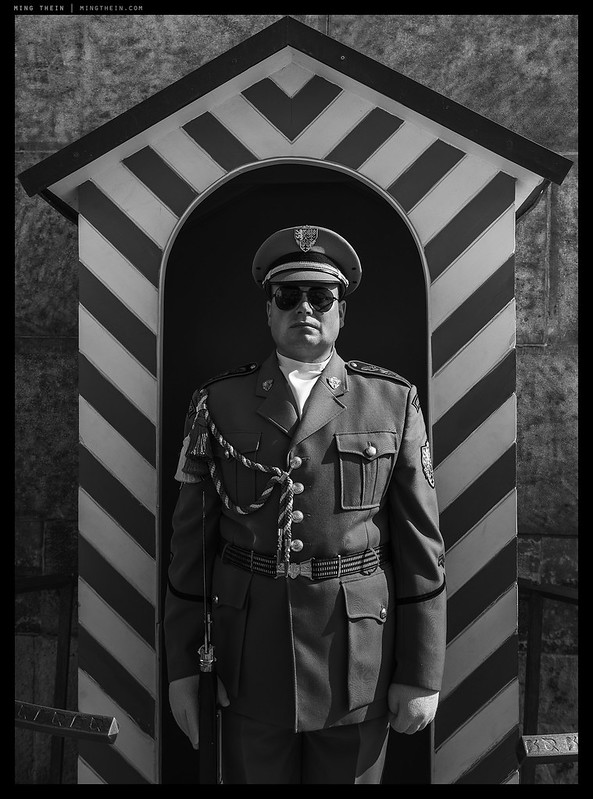
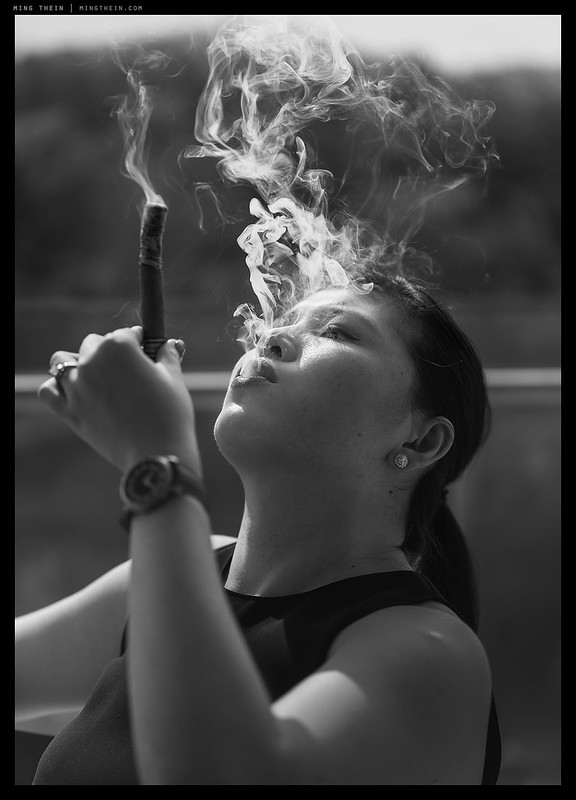






Hi Ming, I visit your site regularly and have purchased a few of your processing classes.
I often feel I’m missing something when I can’t achieve similar results particularly aiming for a low key moody image. The image above of the man sitting in an armchair (H61C-B0006263bw) is a perfect example. I would love to see a before and after with the raw image and the final result. How much is done with lighting and exposure compared to your workflow. Would it be possible for you to share this type of insight?
FC
For optimal tonal information, I always expose to the right and bring it down afterwards – you’ve already seen this in the workflow videos, I think. In this particular case though, ETTR is actually quite close to what you see here because of a) avoiding clipping in the red channel (skin tones) and b) I constructed the lighting for this shot, so you can lock in intended contrast/exposure at the time of capture anyway.
Love your work. You have included a link to the Hasselbald site at the end. Is that because the images were captured with H6d 100c?
Thanks, these were with the H6D-100c or X1D.
Well I actually have quite a bit of your affliction, but it took my direction the other way around, I become more attracted with portraiture, since I learned to observe the human emotion and expressions studiously, and found out that I can make pleasing images while manipulating the energy into that direction.
I come to photography with a background in painting. For me taking portraits within moments is hard ( also an introvert here and all the points you mentioned do apply), but if Im going prepare my subject for a painting I will get better pictures. I have to talk to the subject about what Im looking for. In this manner the shooting will take at least 15minutes (if I have seen and chosen the location and sketched some scenarios before hand) or at most an hour so through this process model has open up. This works good for simple portraits. The harder thing to do is when your portrait is going to tell a story. When I see the portraits of old masters (fine art 17th century to 20th) there is a certain quality to the subjects drawn that has more to do with composition of the model and the environment that is been pictured than the painters technical abilities (or at least as important).
Definitely – time helps, because your subject has had a chance to get comfortable (and I suspect the photographer, also). I wonder if the success of older paintings is also partially because the painter/model had a lot more time to interact than is necessary just for a photograph?
That is one good reason(or as you said necessity) , the serious paintings can take about 10 to 20 hours of work in multiple days and all of that time is spent with the model (because not having a camera so you can print the scene). Along the way you would notice imperfections in scene or pose. As a modern photographer would produce a picture in a day that he/she is proud of , a classical painter at his best would produce 50 pictures in a year.
Geez, you could make a point about selfies actually making people more aware of their facial expressions but you use it to make some silly derisive comment about “duck face”, which hasn’t been as much of a thing for years now. Usually love what you have to say but that’s a little tone-deaf
Actually, it’s still a thing in Asia. And no, people aren’t more aware of their facial expressions.
How much difference do you suppose the camera makes? As in its effect on the subject. People seem very natural around my Leica M6. Waist level viewfinder, like a Rollei, seems good too – you can look at the subject, not be masked behind the camera. I’m not sure about the acuity/sharpness of digital and the generally preferred lenses. In your case, maybe a more formalist approach could be fruitful. Not trying to reveal anything special. Kind of like August Sandler or Thomas Ruff. Supposedly, Paul Strand’s wife did all the interaction with his subjects. OTOH, your pictures from the religious festival (in Thailand?) from a few years ago are stellar.
Warmest regards.
I think not that much so long as it isn’t obtrusive; and that’s both down to size and how much of a deal the photographer makes of the setup. That’s of course assuming you’re not shooting with something that has detrimental inherent limitations like no DOF control or insufficient ambient light ability…
all these portraits are amazing 🙂
Thanks!
Hi,
many thanks for the nice photos, once again!
Portraiture is interesting, beloved (think e.g. of all these selvies and smartphone shots) but a tricky field of photography in my observation. And it is not preliminary about the technical aspects of the actual photo. It’s about the relation between photographer and model.
When in the company I work for, some cooperate shots are taken, often live-view is (almost exclusively) used to allow for an active communication between photographer and the person photographed.
In my personal non-professional experience one interesting aspect is the actual size of the lens: the smaller the better.
When I used Canon’s 40 stm on APC, my “models” felt much more relaxed than with the 6D and the 70-200.
People just feel much less “shot” (or attacted) which shows in the pictures.
Another observation from my private photography is that adults worry much more about what the photo is used for where kids tend to be more happy to have a photo at all.
Kind regards
Definitely – again boils down to human interaction and a portrait being the manifestation of that; too much hardware tends to get in the way…
Love the last one!
Thanks!
I enjoyed the read of this very much, thanks a lot.
I agree to many of your thoughts.
Many portraits try too hard to be perfect, interesting or beautiful and are not honest and without connection to the photographer / viewer as a consequence.
Love the 1st portrait.
Thanks!
As much as these images are perfect (lighting, exposure, composition), I find them (except for #3) so distant. so detached. For portraits (a portrait for me is an image of a head, not a body) I always want to get in as close as possible. The head fills or even overflows the frame, the to-subkect distance is some 60 cms with a 58, the focus is on the near eye, the depth of field is f4.0, so thin…, the transfer form out-of to in to out-of focus is smooth…
They say (at least my late father used to say) “The eyes are the mirror of the soul”. That’s what I want to see. A face, a soul, lunging at you out of a mist.
But sometimes I get more “environmental”. Show me your hands!
Personal preference, I guess. I don’t think a couple of eyes with everything else OOF says enough to me; there’s not enough context…
Context (imho) is relative. It can be seen in an expression (tired, happy, looking away, etc etc), in the lines and curves of a face, a laugh, a sneer.
But I’m less fanatic about it than I used to be; I now tend to, every now and then, include hands, lines or shades in the background, an object.
Oh; and OOF is relative as well. The smooth transition the 58/1.4G (or, to a slightly lesser extent, the 58/1.4 Nokton) provides at f4.0 is something to behold. There’s still a lot to see.
I’ve been working on portraiture for the past year as a new challenge, and probably for the forseeable future. I think the problem of the face or expression showing many different things comes down to the editing phase: during the shoot, I’ll take as many photos as my subject can stand (strobes will wear their eyes out very quickly especially if they’re placed very close to the them!), and we’ll be talking about various things as I try to get what I think I need out of them. And then in the edit, I try to find the right expression that shows what I think is their personality or character: the hit rate for me is often worse than normal shooting even if all of them are exposed well and in focus. And of course, the subject has to agree to the photo as well. Oddly though, the photo I end up using is usually the first photo of a sequence, just like other kinds of shooting.
The other thing for actual sittings is that I like very simple or formal (ie. controlled, intentionally designed) backgrounds too. The whole bokeh’ed out environment look is a pretty tired cliche, and if I had the time and space, I’d construct custom sets for every portrait sitting, a la Dan Winters.
For more environmental portraits, which for me is the person in action at his or her profession (dance choreographers specifically for me), it’s also trying to see when the whole environment comes together to take the photo (eg.. dancers in the right configuration and relation to the choreographer). Often it doesn’t happen, and you go with the safety shot, and sometimes you get very lucky, and all the elements come together, and you get something special. I think that may have happened once or twice in course of thousands of photos.
That sounds about right – sometimes we get lucky and can pick the image we think suits the person best (or rather our impression of their personality) – and sometimes there’s a big disconnect between how they perceive themselves and how we perceive them (I find this tends to happen when there’s no chemistry between you and your subject).
Would also love to construct a set for each shot (never mind portrait) but no such luck! 🙂 The most versatile solution I can think of would be a set of V flats to control light and provide a somewhat variable backdrop as used by countless famous photographers (notably Irving Penn).
That said, if I had results half as good as yours under the circumstances which you work – I’d be very pleased indeed…
Wow, Ming. You just made me blush! I’m gobsmacked and completely flattered! And you’ve also ruined your chance to take a photo of my surprised happy face should I ever sit for you by already telling me that. 🙂
I’ve been studying Irving Penn’s work quite a bit recently, and besides there being so much to see and learn in his work, it’s just a sheer pleasure looking at it.
Hahaha – well, I’ll just have to think of something else 😉
I love #2, it could easily have been taken in the 1940’s.
It’s interesting that quite a large percentage of portraits are done in black and white. I suppose it’s due to the fact that nobody’s perfect, (a somewhat unfortunate hair colour, ruddy complexion, etc), and B&W sort of levels it all out. And, the eradication of colour does force the viewer to focus more on subject and form, and that’s what portraiture is all about, the subject with very little, carefully controlled distraction.
Thanks! My theory about monochrome for portraits isn’t so much eradication of flaws as either a) a sort of mood neutrality that you can’t get when there’s color and suggestion of emotion that comes with it, or b) a sort of timelessness that comes from not having the color palette suggest an era (think of the way certain film emulsions like Kodachrome influence the way we perceive certain periods in history, even though the physical objects don’t change color). Monochrome is somewhat more timeless/objective/classical…
It strikes me that the most successful of these as portraits are the two guys with dark glasses and no eye contact. Plus, of course, your daughter with whom there is an established direct link. As for photos of you, I believe Ian Carroll has produced more than one good one. They may have been shot as candids rather than posed, but the impact is present.
Interesting – all subjects were certainly aware I was shooting them, played up/down to a greater or lesser degree. Perhaps the lack of eye contact (or eyes at all) gives a degree of ambiguity that lets the viewer interpret as they see fit?
Ah yes – Ian did an amazing job considering what he had to work with! 🙂
First, your black & whites here are top notch with 1,3 & 7 being my favorites. I do enjoy taking portraits and despite being introverted, I have never been been self conscious when taking someones portrait. While I may have problems with eye contact when staring at someone without a camera, this completely disappears when I’m shooting a portrait. I think the worst portraits are the professional studio variety as the end result tends to be too sterile and the expression seems forced. It’s a dehumanizing method of taking someones photograph. On the other hand, the best portraits are those of children and candid portraits. With kids, there is a natural look that adults seem too self conscious to achieve. Candids of course are completely natural as the subject is just being him or herself and is unaware of the photo being taken. And personally, I refuse to use flash when doing portraits. It’s natural light or nothing.
I can switch into ‘work mode’ where all self-consciousness disappears; I suppose it’s because you know you’re there to do the job. Harder when you’re shooting your own work for some odd reason – but surmountable if you don’t think about it too much.
I too prefer natural light, but sometimes you have no choice and lighting is needed if you’re in a location with very flat/poor ambient (indoors after dark in most homes, for instance).
Some years ago I was at a festival with my wife (in Japan) when out of nowhere, an elderly gentleman offered to take a picture of us with my camera. As it would have been rude to say no, I handed it over. He raised it to his eye, waited a moment, and then peered over the top with a friendly smile, as if to indicate that he’d taken the picture. My wife and I instantly relaxed and – he told us later – it was at that moment he took the shot, having not moved the camera one inch. The result was probably the most natural looking photo of us that I’ve seen.
It’s probably instructive to read about the great portrait photographers of our time (Annie Leibovitz, Gregory Heisler, Brigitte Lacombe, etc, and – going back a bit – Arnold Newman) and see if there are any common points they talk about. I know that Brigitte Lacombe talks about it being a very instinctive thing which she can’t fully articulate, and Gregory Heisler says that talking to the subjects is critical. But as you imply above, a portrait can say as much about the photographer as the subject – no better example than Newman’s infamous portrait of Alfred Krupp!
I agree with his approach! It’s almost as though you relax after the expectation/anticipation…
“The only way this glance can be meaningful is if the subject intends there to be meaning, and the only way for them to intend there to be meaning is if there is something to communicate in the first place.”
I think you’re 100% right about this, but the part you didn’t highlight is the role of the photographer in seeing that there is something to be commiunicated in the first place and creating a situation that makes that both possible and likely. This is what really distinguishes a (great) portrait photographer from everyone else; their ability to see the story that needs to be told and create the circumstances in which that becomes possible.
I also think you nail the difference between a ‘portrait’ and ‘photograph of a person’ (which you refer to as a ‘fashion image’ but I think applies equally to other pictures of people).
In the images you’ve posted above, my experience of them is that images one and three of ‘portraits’ whereas the others are ‘photographs of people’. I’m not even sure that the degree to which there is a direct look to camera is the differentiating factor because I can think of many exceptional portraits where there is no such look. Consider Dorothea Lange’s portrait of the migrant mother with her children as a case in point.
It’s a great thing in life when you’re able to understand who you are though and what you’re interested in. I admire your words here and your honesty about your Aspergers. Whether you think that limits your potential as a portrait photographer, I think, perhaps ironically, that it expands your potential as a human being. It makes me want to photograph you if you’ll let me.
The ‘seeing something to be communicated’ – in some ways I thought this was a given, else you wouldn’t want to make the portrait to begin with (either you have to do it as a commission, or something in the subject’s personality compels you to).
Curious: in your mind, what differentiates the other images as being ‘photographs of people’ vs portraits?
I would wish you luck in trying to make me look interesting, let alone presentable! 😛
Curious: in your mind, what differentiates the other images as being ‘photographs of people’ vs portraits?
In one simple word, ‘engagement’. In images one and three I as the viewer feel conncted in some way to them, I have a sense of their humanity. The other images lack this but are still fine photographs in their own right, I just don’t ‘see’ them as portraits.
As for whether seeing something in a person is a given, I think it is but like all things there are layers and nuance. There will always be something that makes a person interesting but sometimes while you think you see it infront of you, when you raise the camera it disappears.
Fair, thanks for your thoughts.
For a long time I had considered portraiture to be a big weakness, and over time have made peace with the reality that I just do not find head shots to tell enough if the story. The alternative for me is environmental portraiture, complete with greater depth of field, and when I saw the title of this post I was immediately reminded of your portrait of the Sigma CEO, Kazuto Yamaki. Nice balance of formal and human, relaxed and trusting expression, still a very effective piece.
Thanks!
An introvert with Asperger’s? I did not even notice a trace of the latter during my course in Amsterdam ;-))
Since introverts can relate extremely well to people, the three days were probably not enough time to realise your dominant function – maybe?
I was once told in Chinese culture it was an act of aggression and respectlessness to look into somone’s eyes when talking; is this maybe a reason why you find you have difficulties there (when talking to Caucasians)?
I also had some difficulties interpreting gestures of the Chinese population in Hongkong.
Anyhow, thank you very much for your extremely good portraits – the one I love best was that of the General Manager of Sigma lenses . . .
I’m good at hiding it, and it’s only an issue with large groups for me. I do fine with individuals or small groups (but also why I shifted the group size to smaller workshops). It isn’t the eye thing so much as it being difficult to relate to an individual or identifiable individuals as opposed to a large quantity of people 🙂